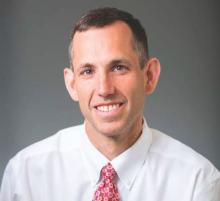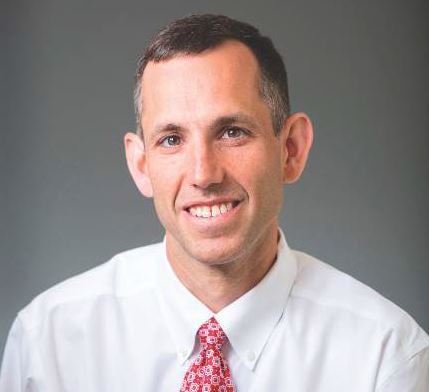User login
While drugs and other medical technologies might be effective in treating cardiovascular issues, a potentially overlooked component is the regular interaction a patient has with his primary care physician, according to Dr. Philip Goodney, who will be discussing research findings during his Saturday presentation, “Why Your Patient’s Primary Care Physician and Internist Are as Responsible as You for the Outcomes of Your Lower Extremity Revascularization.”
“We’ve had some convincing data, whether it’s in the care of diabetes or in the care of high cholesterol or the overall management of cardiovascular disease, that our interventions, whether it’s an operation, whether it’s a stent or combination thereof, tend to last longer and our patients tend to have fewer complications if they are followed closely by a primary care physician,” said Dr. Goodney, associate professor at Dartmouth-Hitchcock Medical Center in Lebanon, N.H..
He said that simple things, such as having a primary care physician ensuring that hemoglobin A1C is regularly checked and monitored, statins as needed are provided when indicated, and regular visits are conducted to monitor chronic illness are occurring can go a long way to improve outcomes.
“While there’s not been good data to support this before, many have thought that the results of our operations tend to be better if patients have primary care physicians that follow them closely,” Dr. Goodney said.
With the support of the Society for Vascular Surgery and the National Instutites of Health, research was undertaken to see if there was evidence to support this notion that better primary care monitoring and follow-up leads to better patient outcomes.
“We did a series of analyses, both within the Vascular Quality Initiative, which is a large quality improvement dataset that is supported by the Society for Vascular Surgery, as well large analyses of patients in Medicare, and found that patients who are commonly seen by their primary care physicians were less likely to have complications after major thoracic aneurysm surgery, were less likely to have complications after procedures to help their lower extremities, and were also more likely to have better results from vascular care,” Dr. Goodney said.
“We thought this was pretty compelling evidence that vascular surgeons should really have, as partners, primary care physicians who actively help manage these complex patients,” he continued. “An effective partnership should translate into better results.”
The research generally showed that rates of complication were often 20%-30% lower in patients who had good care coordination, he said, something that could have the ancillary benefit of lowering health care costs overall.
“I think it speaks to what is sort of low-hanging fruit, if you will,” Dr. Goodney said. “We spend a lot of time in cardiovascular care looking at advanced devices and the latest stent or the latest drug-coated balloon. That might be a pretty expensive way to get better results. But I think what our data show is the answer might be right under our noses and it might be a little simpler than we think.”
He acknowledged that while the solution might be straightforward, “getting care coordination is certainly a challenge. However, I think what our data suggest is that there’s really a bit of a pot of gold at the end of the rainbow if we can make sure these patients get the coordinated care they need.”
Session 102: Why Your Patient’s Primary Care Physician and Internist Are as Responsible as You for the Outcome of Your Lower Extremity Revascularization
Saturday 6:45 a.m. - 6:50 a.m.
Grand Ballroom East, 3rd Floor
While drugs and other medical technologies might be effective in treating cardiovascular issues, a potentially overlooked component is the regular interaction a patient has with his primary care physician, according to Dr. Philip Goodney, who will be discussing research findings during his Saturday presentation, “Why Your Patient’s Primary Care Physician and Internist Are as Responsible as You for the Outcomes of Your Lower Extremity Revascularization.”
“We’ve had some convincing data, whether it’s in the care of diabetes or in the care of high cholesterol or the overall management of cardiovascular disease, that our interventions, whether it’s an operation, whether it’s a stent or combination thereof, tend to last longer and our patients tend to have fewer complications if they are followed closely by a primary care physician,” said Dr. Goodney, associate professor at Dartmouth-Hitchcock Medical Center in Lebanon, N.H..
He said that simple things, such as having a primary care physician ensuring that hemoglobin A1C is regularly checked and monitored, statins as needed are provided when indicated, and regular visits are conducted to monitor chronic illness are occurring can go a long way to improve outcomes.
“While there’s not been good data to support this before, many have thought that the results of our operations tend to be better if patients have primary care physicians that follow them closely,” Dr. Goodney said.
With the support of the Society for Vascular Surgery and the National Instutites of Health, research was undertaken to see if there was evidence to support this notion that better primary care monitoring and follow-up leads to better patient outcomes.
“We did a series of analyses, both within the Vascular Quality Initiative, which is a large quality improvement dataset that is supported by the Society for Vascular Surgery, as well large analyses of patients in Medicare, and found that patients who are commonly seen by their primary care physicians were less likely to have complications after major thoracic aneurysm surgery, were less likely to have complications after procedures to help their lower extremities, and were also more likely to have better results from vascular care,” Dr. Goodney said.
“We thought this was pretty compelling evidence that vascular surgeons should really have, as partners, primary care physicians who actively help manage these complex patients,” he continued. “An effective partnership should translate into better results.”
The research generally showed that rates of complication were often 20%-30% lower in patients who had good care coordination, he said, something that could have the ancillary benefit of lowering health care costs overall.
“I think it speaks to what is sort of low-hanging fruit, if you will,” Dr. Goodney said. “We spend a lot of time in cardiovascular care looking at advanced devices and the latest stent or the latest drug-coated balloon. That might be a pretty expensive way to get better results. But I think what our data show is the answer might be right under our noses and it might be a little simpler than we think.”
He acknowledged that while the solution might be straightforward, “getting care coordination is certainly a challenge. However, I think what our data suggest is that there’s really a bit of a pot of gold at the end of the rainbow if we can make sure these patients get the coordinated care they need.”
Session 102: Why Your Patient’s Primary Care Physician and Internist Are as Responsible as You for the Outcome of Your Lower Extremity Revascularization
Saturday 6:45 a.m. - 6:50 a.m.
Grand Ballroom East, 3rd Floor
While drugs and other medical technologies might be effective in treating cardiovascular issues, a potentially overlooked component is the regular interaction a patient has with his primary care physician, according to Dr. Philip Goodney, who will be discussing research findings during his Saturday presentation, “Why Your Patient’s Primary Care Physician and Internist Are as Responsible as You for the Outcomes of Your Lower Extremity Revascularization.”
“We’ve had some convincing data, whether it’s in the care of diabetes or in the care of high cholesterol or the overall management of cardiovascular disease, that our interventions, whether it’s an operation, whether it’s a stent or combination thereof, tend to last longer and our patients tend to have fewer complications if they are followed closely by a primary care physician,” said Dr. Goodney, associate professor at Dartmouth-Hitchcock Medical Center in Lebanon, N.H..
He said that simple things, such as having a primary care physician ensuring that hemoglobin A1C is regularly checked and monitored, statins as needed are provided when indicated, and regular visits are conducted to monitor chronic illness are occurring can go a long way to improve outcomes.
“While there’s not been good data to support this before, many have thought that the results of our operations tend to be better if patients have primary care physicians that follow them closely,” Dr. Goodney said.
With the support of the Society for Vascular Surgery and the National Instutites of Health, research was undertaken to see if there was evidence to support this notion that better primary care monitoring and follow-up leads to better patient outcomes.
“We did a series of analyses, both within the Vascular Quality Initiative, which is a large quality improvement dataset that is supported by the Society for Vascular Surgery, as well large analyses of patients in Medicare, and found that patients who are commonly seen by their primary care physicians were less likely to have complications after major thoracic aneurysm surgery, were less likely to have complications after procedures to help their lower extremities, and were also more likely to have better results from vascular care,” Dr. Goodney said.
“We thought this was pretty compelling evidence that vascular surgeons should really have, as partners, primary care physicians who actively help manage these complex patients,” he continued. “An effective partnership should translate into better results.”
The research generally showed that rates of complication were often 20%-30% lower in patients who had good care coordination, he said, something that could have the ancillary benefit of lowering health care costs overall.
“I think it speaks to what is sort of low-hanging fruit, if you will,” Dr. Goodney said. “We spend a lot of time in cardiovascular care looking at advanced devices and the latest stent or the latest drug-coated balloon. That might be a pretty expensive way to get better results. But I think what our data show is the answer might be right under our noses and it might be a little simpler than we think.”
He acknowledged that while the solution might be straightforward, “getting care coordination is certainly a challenge. However, I think what our data suggest is that there’s really a bit of a pot of gold at the end of the rainbow if we can make sure these patients get the coordinated care they need.”
Session 102: Why Your Patient’s Primary Care Physician and Internist Are as Responsible as You for the Outcome of Your Lower Extremity Revascularization
Saturday 6:45 a.m. - 6:50 a.m.
Grand Ballroom East, 3rd Floor

